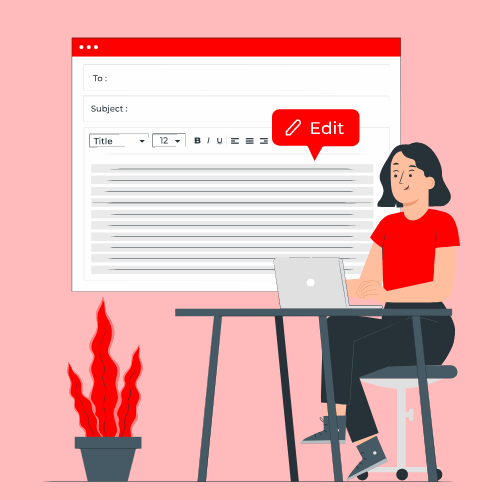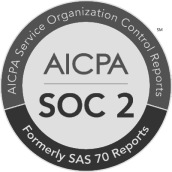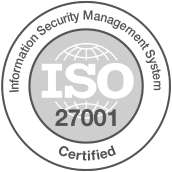Although at first glance, emails might not seem the most optimal marketing channel given its newer contemporaries such as text messages and social media, you would remiss if you think this is not an effective way to create your audience.
For years, businesses have been tapping into the far-reaching potential of email marketing that not only can boost conversions but in the process can enhance profit by multiplying your subscribers.
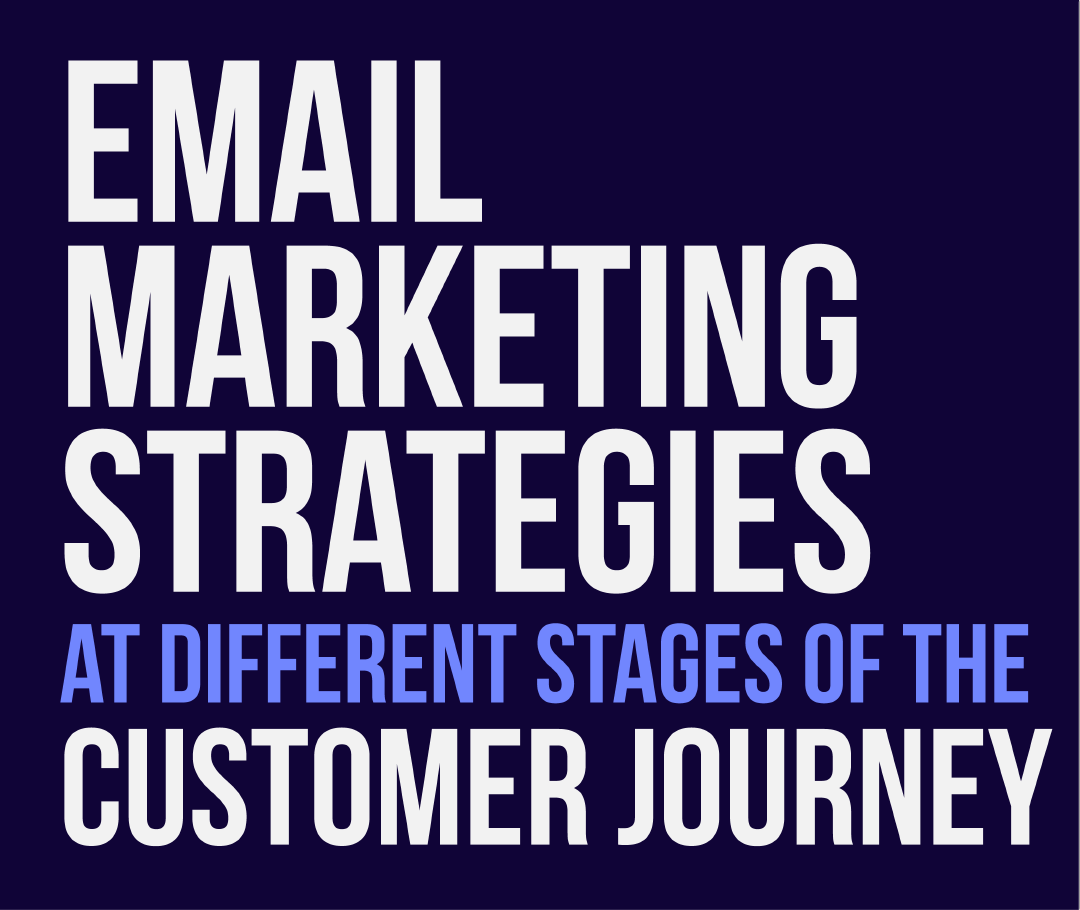
But as with any other marketing channel, this also requires a blueprint that will help decipher the best way to navigate your path to success. We are here to break down what goes into it to give you more clarity on the route you need to follow.
Segmenting Your Email Marketing Leads
As of 2020, there are 4 billion email users in the world. Each email generates $36 for every dollar that is spent. So, it doesn’t take rocket science to understand why emails are constantly pretty high, if not the highest, in the rankings of preferred marketing channels for entrepreneurs.
With such a huge figure, not everyone will fall in the same line of where they stand with your business. This calls for segmenting your email content according to which stage your leads currently are in. You are dealing with humans, not bots here. Sending out generic email blasts will not work.
You need to cater to their unique preferences, interest level, and characteristics. This segmentation will aid you in breaking down your immense list of emails into various sub-categories, which will, in turn, make managing them better.
The readiness of your leads to convert into a customer would vary from person to person. Thus, your treatment of them would differ. The way you interact with someone who already is aware of your products and services would significantly differ from someone who is yet to diagnose their problem. Personalized treatment would help in building more trust, which will make conversions, all the more seamless.
Email Marketing Strategies at Different Stages of the Customer Journey
Although you can segment your leads any way you want, it is wise to segment them through lead magnets and opt-in forms since that would automatically divide them into different categories. You can also segment them through their geographical locations, lifecycle stages, industry, language, and previous relationship with your brand, among others.
Furthermore, the line of business you are addressing – B2B or B2C, will also dictate your decision here since you would be encountering two completely different breeds of people in both of them. For instance, if you are in the B2C sector and are trying to emulate the blueprint of, let’s say, LinkedIn, you would invariably fail since their model is suited exclusively for B2B models.
Here, we are going to break down your client list into four major categories depending on where they currently stand with your brand and how your email marketing strategy has to adapt to each of them uniquely.
Awareness Stage
This is the most nascent stage of the client you are going to deal with. So, practice patience since getting their attention would be the most difficult among everyone else. However, once you get that ball rolling by making an enticing first impression, you can rest assured that half the battle in converting your leads into customers is won.
Goals
The primary goal while formulating the content strategy of your email marketing system for these leads is to remain present on top of their awareness set. They have to know that you exist and that you are the answer to their problem-solution. Focus on educating them about your niche/industry and let them get acquainted with what you have to offer.
Target Audience
Understanding your target audience is crucial in determining what angle of treatment you provide them with. In this case, you are dealing with a sect of people who are slowly coming to terms with their problems/requirements. As the name suggests, they are getting aware of the present scenario. It is all about identifying the issues for them at this stage.
Types of Email
- Event Invitation
Pretty self-explanatory, this sort of email works as a great vehicle to invite your prospects for an upcoming event that you would be hosting. Incorporate a lot of visuals to ensure people register for the event since events cost money and you need to make sure every penny of yours is worth it.
- Welcome Email
This is an efficient tool to thank everyone who has signed up for a product trial or has subscribed to your newsletter. Be sure to highlight your brands as well as let your prospects know what it is for them.
- Newsletters
31% of B2B marketers rely on newsletters to nurture leads. A newsletter is considered a profitable tool to build camaraderie amongst the prospects regarding your brand. The weekly/fortnightly/monthly release of blogs and brand news helps keep the attention of your prospects warm.
Email General Hygiene Factors
- Length
Since this is the awareness-building stage, you can go generous with the length. Give thorough details about your concerned subject to your prospects and familiarize them with your intent.
- Language
Formal, informal, as well as a mixture of both, can be adopted. The idea is to grab their attention, which is why you can be liberal in your approach based on your brand.
- Personalization Level
Keep the personalization at a minimal level since the prospects aren’t looking for loyalty at this stage. Remember, this is still a nascent stage. However, make sure they feel part of the community.
- Email Content
The content has to revolve around educational resources as you are attempting to get the prospects acquainted with the problem as well as how you are the solution.
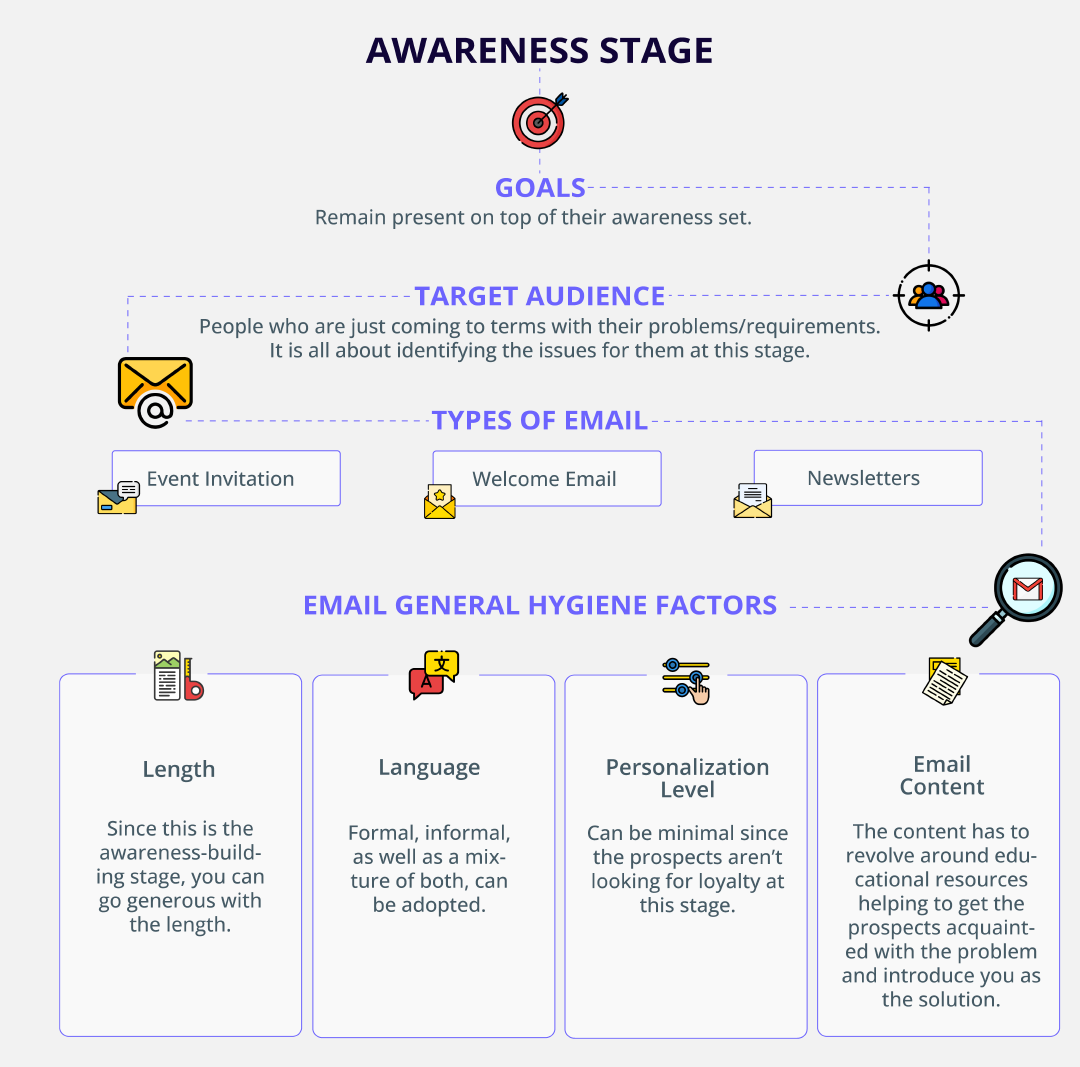
Consideration Stage
At this stage, the prospects are aware of how you provide a solution to their problem. Here, you have to go in-depth and make them believe why you are better than your peers and why they should consider you.
Goals
Your goal here is to ensure that your leads know more about both your brand as well as the specific product you are trying to sell. Position your product as per your business needs and make them believe why they should invest their time and money in your product(s).
Target Audience
The target audience here has a better grasp on what they are looking for since they understand their requirement with much more clarity than in the stage before this.
Types of Email
Apart from event invitations and newsletters that we explained in the previous stage, two new types of email marketing that you can employ here are.
- New Content Announcement Emails
This is what you need when you have to announce your next coupon trial, ebook, sale, or webinar, among others. These emails help in defining and promoting an upcoming marketing offer with a call-to-action button which will lead them to a targeted page.
- Joining Community
Similar to welcoming emails, this marketing process directly involves inviting leads to join the community of your specific brand, be it through a call-to-action button that leads to your social media pages or just by becoming a subscriber by login into your website. This ensures that the leads remain constantly engaged and up-to-date with any product development.
Email General Hygiene Factors
- Length
Detailed length is also welcome at this stage because you are still in the process of captivating your leads’ attention. The more your prospects know about the positives of what you are selling, the more inclined they would be in investing in you.
- Language
Depending on your line of business, formal, informal, or a mixture of both is fine. This is extremely subjective but usually keeping a fusion of both formal and informal language gets the job done.
- Personalization Level
Although a level up from the previous stage, you still shouldn’t offer too much personalization since you are not familiar enough with the preferences of your leads. That being said, continue building a rapport with them.
- Email Content
Relying on a webinar and other similar resources, keep the content informative without being preachy. Don’t try and oversell and drive off the leads. In addition, ensure that you are not sending irrelevant content to your subscribers. It doesn’t take much for people to unsubscribe.
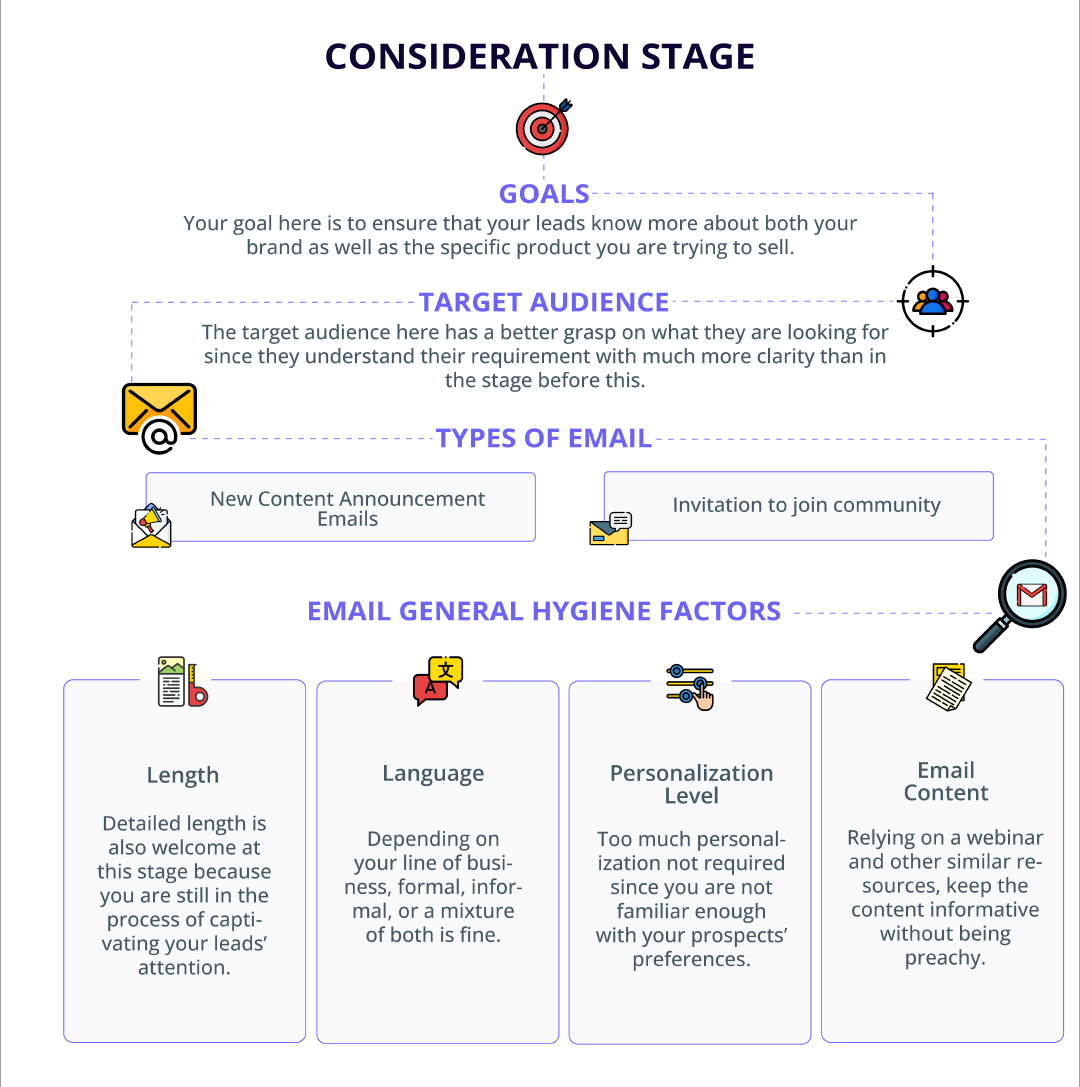
Conversion Stage
An extremely pivotal stage that dictates whether your hard work so far has paid off or not, the conversion stage is where you have to set yourself apart. This is where your leads will turn into customers.
Goals
The goal at this stage is to make your leads see your USP (Unique Selling Point); to make them understand why they should pick you over other choices available in the market. Let them know of any discount that might be going on. Keep engagement alive by constant text messages and booking calls.
Target Audience
The target audience here is the toughest nut to crack. They have all the information regarding your product and they are weighing their options. So, grabbing and maintaining their attention towards you and you alone is an absolute necessity.
Types of Email
Explore event invitations, new content announcement emails, and newsletters, and workshop them to suit the specific target audience of this stage.
Email General Hygiene Factors
- Length
Keep it precise. All detailed and thorough information has already been relayed in previous stages. This is where they need cutting, sharp, short, and to-the-point messages. This is where you need to stop bombarding your prospects with every piece of information. They already have the relevant information with them.
- Language
This is where you start making your prospects a part of the brand’s family. So, don’t be hard-pressed to keep everything too formal. But as with the previous stages, keep mixing it up between formal, informal, and a mixture of both.
- Personalization Level
Keep personalization a level up from the previous stage yet not to a degree where you have to prioritize it over other aspects that need more attention. You don’t want to invest in personalization in prospects at this stage since it won’t guarantee you returns.
- Email Content
Styled in the form of webinars, be sure not to overwhelm your leads with too much contact. Maintaining regular contact is not synonymous with bothering your leads 24x7. Give space and room to breathe to your prospects.
Retention Stage
The final stage is where you are dealing with people who have already invested their resources in your brand and products. These are your customers – the ones you are dependent on.
Goals
The primary goal is to retain customers so that they are more than one-time buyers. Encourage them to purchase again. Focus on upselling and finding ways to delight your subscribers with relevant content and wholesome service.
Target Audience
Your target audience is familiar with your product. Based on their experience, you need to keep supplying them if they are delighted with the experience and strive for better if they aren’t satisfied.
Types of Email
In addition to new content announcement emails and newsletters, bring the following type of email marketing into your blueprint.
- Feature Updates
Any changes in your product that you have made either after getting feedback or out of motivation to serve better, you need to let your customers know. This email marketing system helps in making your customers come back to you again and again.
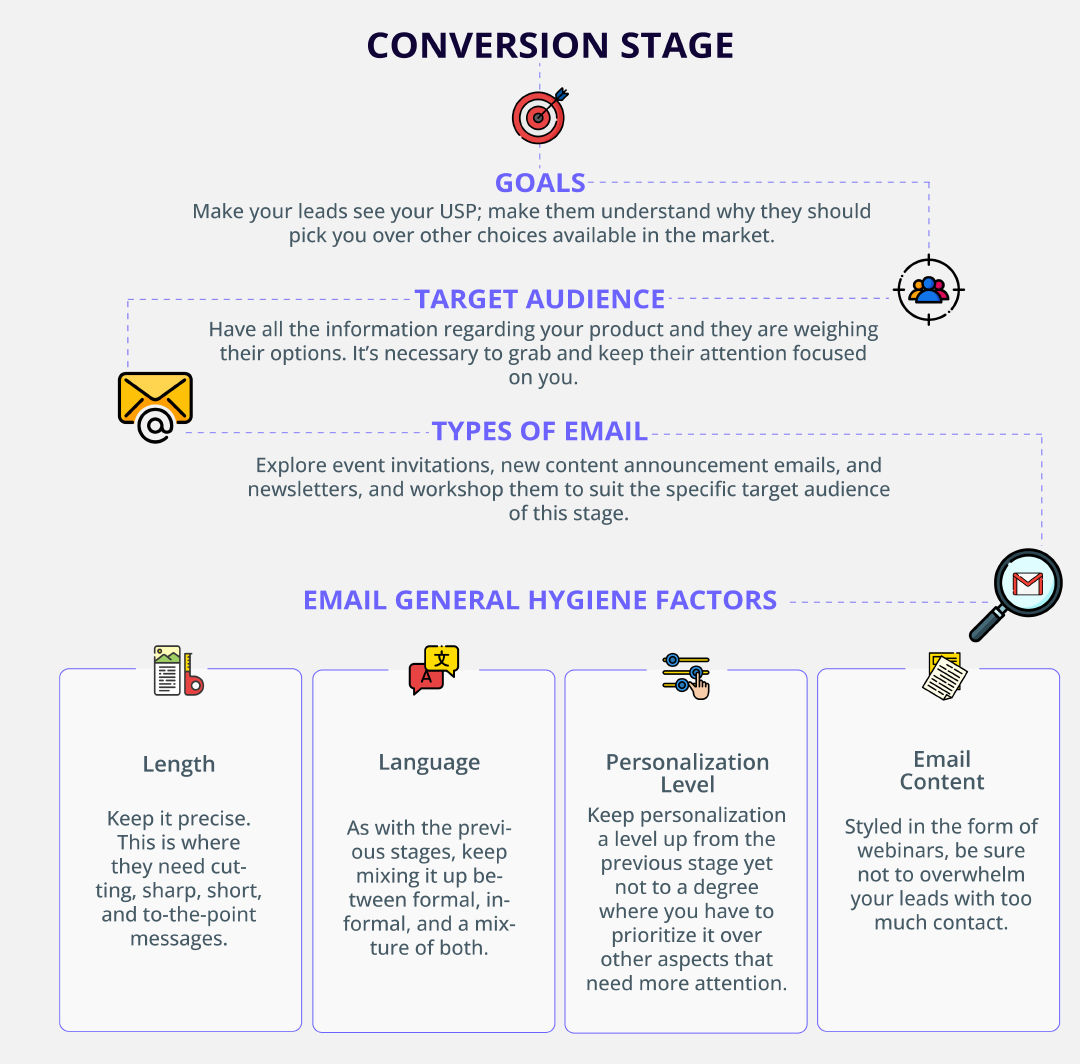
Email General Hygiene Factors
- Length
Be flexible with the length since you would have to adapt according to the campaign you are under. Your clients already are aware of who you are. So, gentle reminders don't have to be too thorough or cumbersome.
- Language
Keep it formal for B2B sectors and informal and/or hybrid for B2C sectors. Clients appreciate consistency and it is ideal to maintain the language that has so far worked for you. If it ain’t broken, there’s no need to fix it.
- Personalization Level
Maintain the highest level of personalization since you know your customers well enough by this point and have to cater to their preferences. This is where you prioritize and invest in personalization since that is what your clients would expect of you. Catering to their needs would assist in their retention.
- Email Content
Sourced as webinars, make sure your content is not overbearing. Focus on providing engaging content while mixing it up to ensure your customers aren’t bored. The idea is not to fade away from their memories while not being a nuisance.
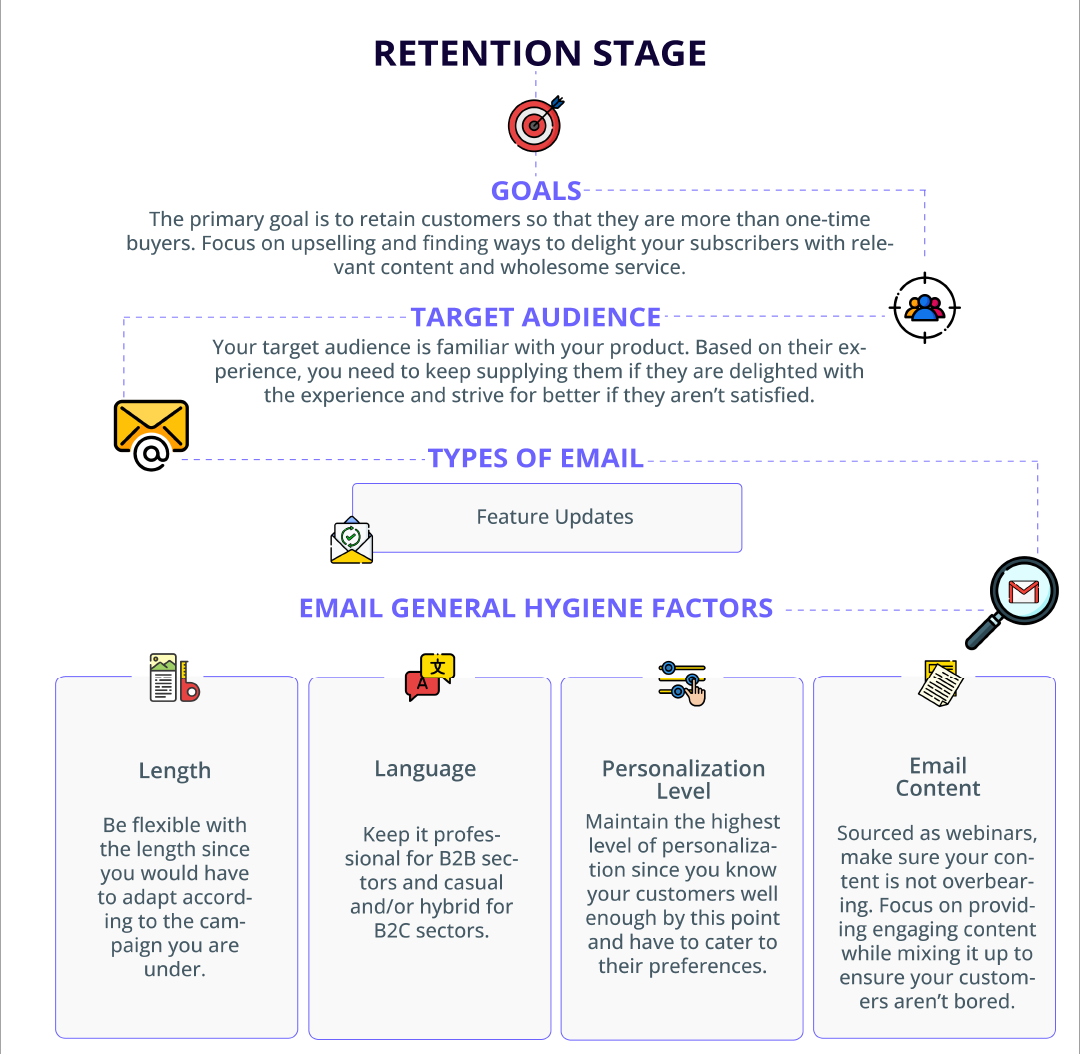
Design Elements of an Email
Before we wrap up this guide, we want you to have an idea about the different elements that you need to put in an email article to maximize its marketing potential. These elements are pretty self-explanatory– all you need to do is tweak them up in accordance with your line of business. So, that being said, an email article should have the following elements.
- Subject line
- Header
- Body copy
- Images and logos
- Call-to-action buttons
- Footer

A marketing email can form the base of your entire marketing campaign and can set the tone for other marketing channels. Don’t undermine it and make the most of it to give your brand the boost it needs.

